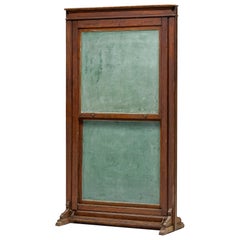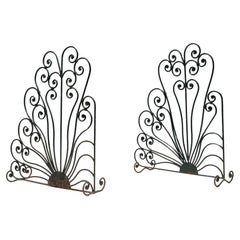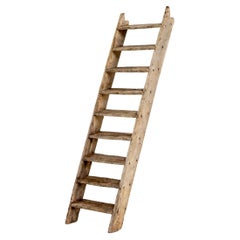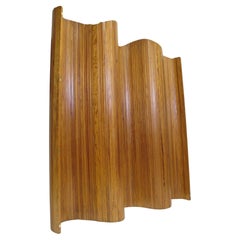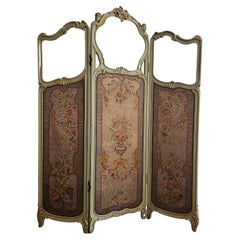Goldwood Interiors Home Accents
to
5
5
1
5
5
1
1
4
1
1
1
5
4
1
5
5
5
1
Rotating Antique School Chalkboard, France, Early 20th Century
Located in Antwerp, BE
This early 20th-century rotating school chalkboard, known as “Le Perfect,” is an authentic registered model by L. Decunsel. Made in France, it features a solid wood frame with dual g...
Category
Early 20th Century French Rustic Screens and Room Dividers
Materials
Wood
Orientalist Room Divider in Wrought Iron, France, 1900s
Located in Antwerp, BE
Oriental room dividers, inspired by the Han Dynasty's rich craftsmanship and handcrafted from enduring wrought iron - the very "iron" that shape...
Category
Antique Early 1900s French Organic Modern Screens and Room Dividers
Materials
Wrought Iron
Rustic Climbing Frame, France, 20th Century
Located in Antwerp, BE
Rustic; Climbing Frame; Ladder; Monoxylite; Wabi Sabi; Antique; France; 20th Century; Art Populaire; Travail Populaire;
Rustic climbing frame from the ...
Category
Early 20th Century French Rustic Ladders
Materials
Wood
Rustic Art Populaire Ladder, France, 20th Century
Located in Antwerp, BE
Rustic; Art Populaire; France; Early 20th Century; Monoxylite; Wabi Sabi; Travail Populaire; Folk Art;
Rustic French ladder adorned with a fascinating patina. This unique piece embo...
Category
Early 20th Century French Rustic Ladders
Materials
Wood
Important Room Divider by Michel De Klerk
By Michel De Klerk
Located in Antwerp, BE
Important room divider with significant detailing of the Dutch 'Amsterdamse School' period.
Michel De Klerk might be the most renowned architect of ...
Category
Vintage 1920s Dutch Art Deco Screens and Room Dividers
Materials
Wood
Related Items
French Art Deco tambour screen room-divider
By Alvar Aalto
Located in Oakland, CA
French Art Deco tambour room divider / folding screen crafted of heart pine, can be coiled and shaped into multiple positions to fit the space as needed. Possibly Baumann et Fils, Me...
Category
20th Century French Mid-Century Modern Screens and Room Dividers
Materials
Pine
French Luxury Folding 3 Panel Screen, room divider
Located in Waasmunster, BE
French Luxury Folding 3 Panel Screen, room divider
Category
Vintage 1960s French Louis XIII Screens and Room Dividers
Materials
Glass
19th Century French Folding Library Step Ladder
Located in Rio Vista, CA
Handsome late 19th century French country folding library ladder. Featuring a handcrafted design with seven rungs or steps and iron hardware. From an estate in Santa Barbara, CA.
Category
Antique 19th Century French Country Ladders
Materials
Iron
Ornate Decorative Wrought Iron Four Fold Room Divider Screen c 1950/70's
By Woodard Furniture Co.
Located in New York, NY
Exceptional ornate four fold wrought iron screen, room divider constructed of four sections each with a cathedral style top over rectangular panels.
The iron is worked into repea...
Category
Mid-20th Century Spanish Rococo Revival Screens and Room Dividers
Materials
Wrought Iron
$1,950
H 74 in W 60 in D 0.5 in
Early 20th Century French Black Leather Traveling Trunk with Brass Detailing
Located in Fayetteville, AR
Originally used in the 1920's to carry goods for a traveling salesman, this small scale French wooden traveling trunk is covered in black leather a...
Category
Early 20th Century French Trunks and Luggage
Materials
Brass
$995
H 14 in W 20.5 in D 12.5 in
Early 20th Century Austrian Library Ladder, Antique Folk Art
Located in Nuernberg, DE
Created in Austria around 1920s and standing strong and very sturdy, this is a real beauty in every House. Versatile and practical, the elegant essential is in very good used conditi...
Category
20th Century Austrian Mid-Century Modern Ladders
Materials
Wood
Early 20th Century Musical Bird Automaton
Located in Middleburg, VA
An automated singing bird with a strong voice and flamboyant plumage amidst foliage in a gilded brass cage. Germany, circa 1920.
This beautiful, vintage songbird collectible will ad...
Category
Early 20th Century Bird Cages
Materials
Metal, Brass
French 20th Century Oak Library Stairs
Located in Baton Rouge, LA
French 20th century oak folding ladder or library stairs. The design of the ladder is remarkable for all the engineering required to make it portable and stable without sacrificing t...
Category
20th Century French Other Ladders
Materials
Metal
Foldable wooden room divider
Located in Diest, BE
Foldable wooden room divider, Behrens Hannover, Germany, early 20th
Category
Vintage 1930s German Screens and Room Dividers
Materials
Wood
Early 20th Century French Black Leather Steamer Trunk with Brass Detailing
Located in Fayetteville, AR
This French wooden steam trunk from the early twentieth century is covered in black leather and features wooden runners and brass corners that offered protection from damage when tra...
Category
Early 20th Century French Trunks and Luggage
Materials
Brass
$1,995
H 21.5 in W 26.5 in D 23 in
Wicker Screen Room Divider
Located in New York, NY
A blonde/light tan wicker four (4) screen room divider with brass hardware. Very good condition as shown in images and video. Dimensions: Full Width 70.63", Height 71.63", Depth 1". ...
Category
Early 2000s Screens and Room Dividers
Materials
Brass
Early 20th Century English Leather-Clad Pole Ladder With Brass Mounts
Located in Charlottesville, VA
An exceptional early 20th century English pole ladder clad in rich brown leather and detailed with brass mounts and rows of nailhead trim. The combination of patinated metal, aged le...
Category
Early 20th Century British Ladders
Materials
Brass
